Chapter 21 Bury-Saint-Edmunds Via USA
 hesitate before starting this chapter. Father Time is crossing the line from 1799 to 1800 and with it is bringing a new box ticking culture. All over the world's countries start taking records and censuses seriously. We can follow a middle or upper class class person being born, being educated, being married, boarding a boat and disembarking the other end, building a business, building a family and burying the dead. To simply try to include all this information would make this chapter extremely boring and impossibly long314. Far better to let the reader choose the interesting information from the readily available sources.
hesitate before starting this chapter. Father Time is crossing the line from 1799 to 1800 and with it is bringing a new box ticking culture. All over the world's countries start taking records and censuses seriously. We can follow a middle or upper class class person being born, being educated, being married, boarding a boat and disembarking the other end, building a business, building a family and burying the dead. To simply try to include all this information would make this chapter extremely boring and impossibly long314. Far better to let the reader choose the interesting information from the readily available sources.
No, the purpose of this chapter is first to tie up some loose ends of Limmers from pre-census era. Second, to show how Limmers expand rapidly all over the world from here on. Third, to show how descendants of one family begin to diversify in interest and outlook so widely from another branch. Fourth, to show how the fortunes or misfortunes of one person in any chain can affect a line for generations to come.
So then, leaving aside the numerous side shoots of this productive line of Limmers, we focus in on a few of the Bury-Saint-Edmunds group.
By the time of the 1821 census, James(1801.64) born New Buckingham Norfolk, had travelled to USA and returned with two children to settle in a set of terraced houses marked on the Bury-Saint-Edmunds map of 1801 as ‘Limmer Terraces’ and situated opposite St Mary’s park in Bury-Saint-Edmunds. The family occupied 61-67 Field Lane known as Limmer Terraces. Maria Howe (17 years old) was listed as servant.
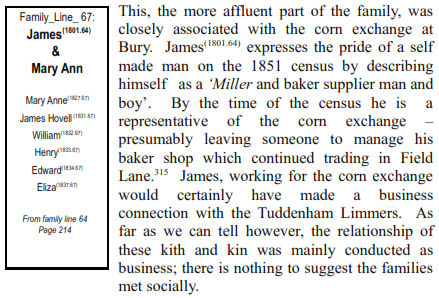
James Hovell(1864.67) moved from New Buckingham in Norfolk. His father John(1734.U), a blacksmith, was born, built his business in, and died a native of Buckingham. Why James came to Bury, we do not know. He moved with enough time to set up his baker shop and establish himself in the corn exchange before the 1881 census. He accumulated wealth enough to educate his son at the prestigious King Edward Grammar School, where he is listed as ‘ Loyalist’. Loyalist did not denote his allegiance to the king. The tradition of the grammar school was to call Bury residents ‘Loyalist’ and all others folk as ‘Foreigners’. Such terms in themselves set the pupils mindset in as forerunners of the elite public schools of today. No doubt, this branch of the family drifted apart from their Tuddenham relations by subject of politics, values and class. To do well in the corn exchange required conformity to the establishment because it had the ear of the King.
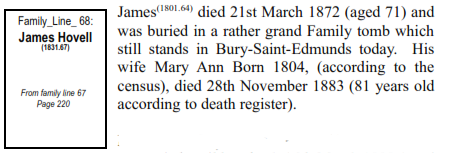
Daughter Mary Anne, Born 1828, remained unmarried until her death 16th March 1898 (aged 71 according to the death register), being buried in the same family grave. The graveyard of St Mary’s Cemetery is opposite Limmers Terraces in Saint Mary’s, Bury. James and Mary Ann also had a son, Edward, born 1834 and a Daughter, Eliza (Elizer), born 1836.316
The brother of James, John Davy, also born in New Buckingham in 1798, moved to Bury-Saint-Edmunds Married Lucy from Stowmarket in 1828. Lucy was nine years younger than John Davy was. She was born in 1807. John and Lucy had a son William (born 1829) a daughter Lucy, (born 1830) three years later in 1833, they had another daughter, Louisa. As soon as William had finished his schooling, his father set him up in a bakers
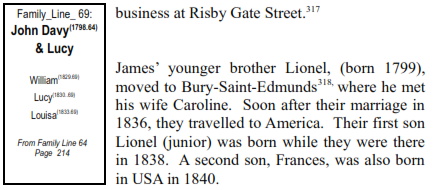
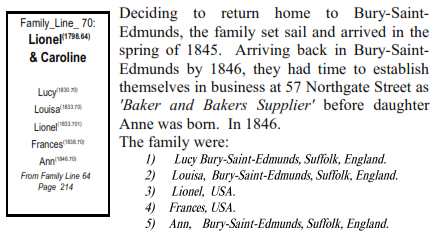
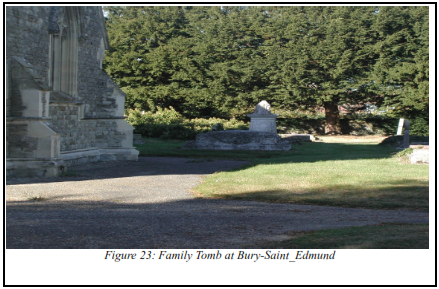
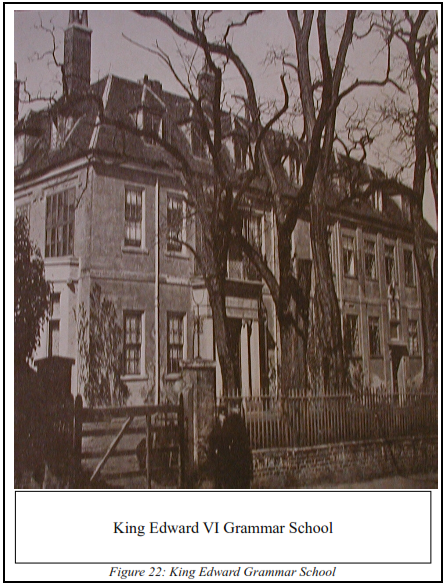




 hesitate before starting this chapter. Father Time is crossing the line from 1799 to 1800 and with it is bringing a new box ticking culture. All over the world's countries start taking records and censuses seriously. We can follow a middle or upper class class person being born, being educated, being married, boarding a boat and disembarking the other end, building a business, building a family and burying the dead. To simply try to include all this information would make this chapter extremely boring and impossibly long
hesitate before starting this chapter. Father Time is crossing the line from 1799 to 1800 and with it is bringing a new box ticking culture. All over the world's countries start taking records and censuses seriously. We can follow a middle or upper class class person being born, being educated, being married, boarding a boat and disembarking the other end, building a business, building a family and burying the dead. To simply try to include all this information would make this chapter extremely boring and impossibly long




